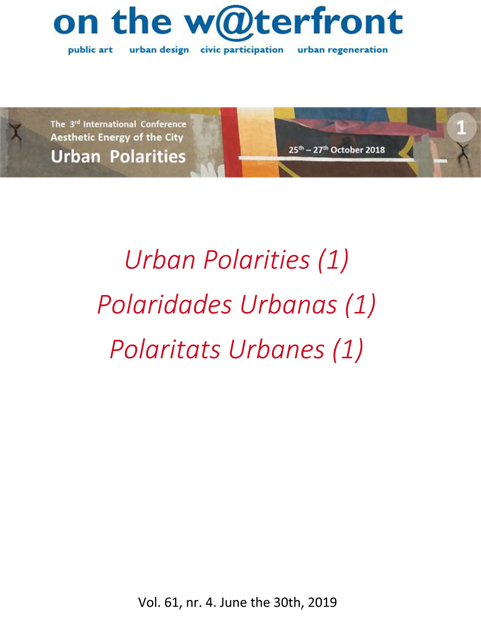L’entorn informatiu de la creació estètica de solucions respectuoses amb el medi ambient i l’aplicació de fonts d’energia alternatives a les zones suburbanes.
DOI:
https://doi.org/10.1344/waterfront2019.61.6.5Paraules clau:
information environment, renewable energy, suburbs, aesthetics of technology, landscape protectionResum
Després d’un període de fascinació pel propi fet de generar energies renovables barates, estem entrant en un període de recerca de solucions que no només serien útils sinó que també tindrien una forma atractiva. La societat de la informació posa a disposició dels dissenyadors la tasca d’assegurar que les solucions respectuoses amb el medi ambient es converteixin estèticament en una part integral d’un emplaçament arquitectònic o d’un traçat urbà i no tinguin un impacte advers sobre el paisatge. El progrés tecnològic en l’aplicació de tècniques digitals millora enormement les eines de l’arquitecte en aquesta matèria, ja que permet no només la modelització de sistemes a l’espai virtual de l’ordinador sinó també la simulació de processos a la recerca de solucions òptimes, mantenint el control del forma. Aquesta investigació pot ser una eina que afavoreixi la protecció del paisatge cultural i natural. L’objectiu d’aquest article és analitzar alguns dels èxits recents en l’ús de la simulació per ordinador, la seva utilitat per configurar i controlar el paisatge suburbà, i en particular les solucions que treuen energia del sol.
Referències
ACKOFF, R. L. and SASIENi, M. (1968) Fundamentals of operations research. New York: Wiley.
GASPARSKI, W. (1988) Projektoznawstwo : elementy wiedzy o projektowaniu. Warszawa: Wydawnictwa Naukowo-Techniczne.
KOLAREVIC, B. and MALKAWI, A. M. (2005) Performative Architecture: Beyond Instrumentality. doi: 10.1111/j.1531-314X.2006.00068_1.x.
KOWAL, S. et al. (2017) ‘Digital Method for Verifying Archaeological Hypotheses. Medieval Gord Under Pułtusk Castle’, Studies in Digital Heritage. doi: 10.14434/sdh.v1i2.23412.
OLSSON, T. et al. (2012) ‘User evaluation of mobile augmented reality in architectural planning’, in eWork and eBusiness in Architecture, Engineering and Construction. doi: 10.1201/b12516-116.
PEREIRA, P. M. M., MONTEIRO, G. A. and PRAZERES, D. M. F. (2015) ‘General Aspects of Biomimetic Materials’, in PACHECO TORGAL, F. et al. (eds) Biotechnologies and Biomimetics for Civil Engineering. Cham: Springer International Publishing, pp. 57–79. doi: 10.1007/978-3-319-09287-4_3.
RIFKIN, J. (2012) ‘The Third Industrial Revolution- How Lateral Power Is Transform-ing Energy, The Economy, and the World’, World Future Review (World Future Society). doi: 978-0230341975.
SCHMITT, G. (1999) Information Architecture: Basics and Future of Caad. Birkhäuser--Publishers for Architecture (IT revolution in architecture). Available at: https://books.google.pl/books?id=5lMJ2uHt6J4C.
SŁYK, J. (2012) Źródła architektury informacyjnej. Warszawa: Oficyna Wydawnicza Politechniki Warszawskiej (Prace Naukowe Politechniki Warszawskiej. Seria Architektura 7).
SOWA, J. et al. (2017) Budynki o niemal zerowym zużyciu energii. Oficyna Wydawnicza PW.
TWAROWSKI, M. (1970) Słońce w architekturze. Wyd. 3. Warszawa: Arkady.
WRONA, S., MILLER, D. and KŁOS, J. (1996) Rola Informacji w Projektowaniu Architektonicznym. 0336/S1/93/04. Warszawa.
Descàrregues
Publicades
Com citar
Número
Secció
Llicència
 La llicència us permet: Compartir - copiar i redistribuir el material en qualsevol mitjà o format i Adaptar - remesclar, transformar i construir sobre el material per a qualsevol propòsit, fins i tot comercialment. El llicenciador no pot revocar aquestes llibertats mentre l'usuari compleixi els termes de la llicència. Els drets d'autor estan protegits per ISSN 1139-7365. A la revista w@terfront no hi ha restriccions de drets d'autor i permet als autors conservar els drets de publicació sense restriccions.
La llicència us permet: Compartir - copiar i redistribuir el material en qualsevol mitjà o format i Adaptar - remesclar, transformar i construir sobre el material per a qualsevol propòsit, fins i tot comercialment. El llicenciador no pot revocar aquestes llibertats mentre l'usuari compleixi els termes de la llicència. Els drets d'autor estan protegits per ISSN 1139-7365. A la revista w@terfront no hi ha restriccions de drets d'autor i permet als autors conservar els drets de publicació sense restriccions.Aquesta revista no cobra als autors cap taxa per enviar o processar articles.







